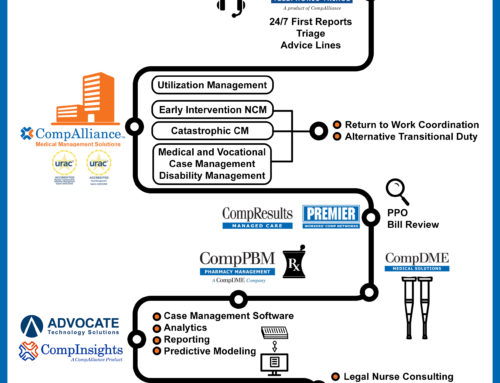Return to Work vs. Return to Function – Government/Regulators Part 5
In Part 4 of this series, dated 11/9/2018, I discussed the “What’s in It for the Insurer” regarding RTW. Today I will discuss the common perceptions, misconceptions and the “What’s in it for the Government/Regulator, and a best practice statement by the IAIABC. Please refer to my post dated 9/26/2018, for the list of all stakeholders we identified.
Reality of Why Government/Regulators Should Care About Return to Work?
When a worker does not return to work following an injury:
- The International Labour Organization estimated that the global GDP experiences a 4% loss due to work-related injuries
- For the jurisdiction, the tax base shrinks, reducing tax revenue
- Reduced earnings decrease spending which leads to lower economic activity
- Workers who return to work are less likely to end up on government safety nets for disabilities and healthcare (Social Security Disability Insurance and Medicare in the US)
- The removal of workers from the labor force can have damaging effects to society as a whole
State Financial Incentives to Establish Stay-at-Work/Return-to-Work (SAW/RTW) Programs
A number of state workers compensation programs include incentives to encourage employers to adopt Stay-at-Work/Return-to-Work Programs. These incentives are designed to facilitate workers who become injured, ill or disabled to remain on the job or return to work following illness or injury. Some states interpret “stay-at-work” and “return-to-work” broadly to include workplace safety and illness and injury prevention programs. Incentives include premium adjustments or discounts, wage subsidies for hiring injured workers, and repayment for the purchase of special equipment purchased for employees returning to work after illness, injury or disability. Below are some examples of these types of programs and policies.
For example, Colorado , Massachusetts , and North Dakota’s programs are mainly focused on injury prevention, however the North Dakota program, Preferred Worker Program also offers reimbursement of up to 50 percent of wages (not to exceed the States Average Weekly Wage) for employers who hire participants in the program.
Ohio’s Transitional Work Bonus Program assists employers in developing a worksite program that helps injured workers perform transitional work while they recover. Employers with an approved transitional work plan may receive a back-end bonus for using the plan to return injured workers back to work. The potential incentive is a 10 percent bonus for using an established transitional work program.
Oregon has two programs that help employers bring injured workers back to the job quickly and safely. The Employer-at-Injury Program (EAIP) provides employers with wage subsidies, reimbursement for worksite modifications and other accommodations costs to help workers stay at work. The Preferred Worker Program (PWP) is targeted to employers who hire injured workers. This program exempts premiums for the costs of w/c insurance on a preferred worker for three years. In addition, the Division repays the employer 50 percent of the preferred worker’s wages for 183 days and the costs of a new w/c claim if the preferred worker files on during the three-year exemption period. It also covers many expenses required to help a worker find, accept or keep a job in Oregon.
Participants in Texas’s Return-to-Work Reimbursement Program for Employers may be eligible for either reimbursement or an advance payment of up to $5,000 to pay for special equipment, furniture and other workplace alterations that enable an injured employee to return to work. To apply for an advance, employers must submit a request for payment before they incur the expense.
Washington’s stay-at-work program allows for reimbursement of return-to-work costs, including 50 percent of base wages of injured workers (up to a $10,000), as well as the costs of certain accommodations, training, tools and clothing. Washington also has a program through their Centers of Occupational Health and Education (COHE) through which trained health service coordinators work directly with medical providers, employers and injured workers to coordinate care and return-to-work activities.
State vocational rehabilitation agencies may be able to help employers with some of the costs associated with assistive and rehabilitation technology for employees with disabilities. Employees who are VR clients can request VR assistance to help pay for this type of technology and other employment supports, such as sign language interpreters and readers. For more information, employers can contact the Council of State Administrators of Vocational Rehabilitation’s National Employment Team (NET).
What Works? Opportunities for policymakers and workers’ compensation agencies detailed in the IAIABC paper titled, “Return to Work; A Foundational Approach to Return to Function”
- Further strengthen anti-discrimination laws to enforce equal opportunities in employing people with disabilities. For example, in the United States, the Americans with Disabilities Act (ADA) mandates accommodation for employees with a disability.
- Ensure that the enabling legislation that creates the workers’ compensation system in the jurisdiction charges the workers’ compensation system with the responsibility of returning injured workers to work. See the Appendix for a list of U.S. workers’ compensation statutes and examples on how three jurisdictions have included return to work in their workers’ compensation acts/statutes.
- Develop laws, policies, or programs that incentivize companies and public organizations to invest in early return to work. This could include tax incentives, matching funds, or wage subsidies.
- Consider legislation and/or regulations requiring employers and injured workers to participate in post injury return to work programs.
- Evaluate existing rules, regulations, statutes, policies, etc. that may preclude, restrict, and/or limit return to work/stay at work initiatives.
- Require insurers and claim administrators to provide return to work services and return to work information to policyholders. Many jurisdictions require insurers to provide risk management and prevention services; similar requirements could be mandated for return to work.
- Afford opportunities for mediation and dispute resolution programs specific to return to work as opposed to judicial or administrative rulings solely based upon “findings of fact”.
- Inclusion of set fees in a medical provider fee schedule should be considered to compensate medical providers for the extra time to complete return to work and physical capabilities forms and participate in meetings to discuss return to work.
“Governments, including regulators and legislators, need to support and encourage investments in early return to work through sound public policy, engagement, and collaboration with workers’ compensation stakeholders in order to support economic growth and promote a healthy society.”
In Summary
Tremendous strain is being placed on economies and healthcare systems around the globe by life-altering, preventable workplace injuries and long-term disability. The resulting costs to state and federal governments are large. Injuries or illnesses that hinder a worker’s ability to work are a major challenge to economic productivity. They increase labor costs and disrupt business operations. Employees injured and not working are not earning taxable income or are earning a reduced level of income. Policymakers interested in economic growth and reducing dependence on social programs should shape policy to invest in return to work.




